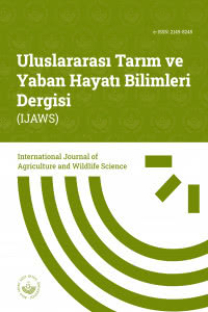Bazı Hibrit Kestane Genotip ve Çeşitlerinin Aşı Performanslarının Belirlenmesi
Castanea spp., Yongalı göz aşı, Ana bitki, anaç
Determination of The Grafting Performance of Some Hybrid Chestnut Genotypes and Cultivars
Castanea spp., chip budding, mother plant, rootstock,
___
- Akyüz, B., & Serdar, U. (2020). Generative rootstock potential of some hybrid chestnut genotypes. Anadolu Journal of Agricultural Sciences, 35, 185-191. https://doi.org/10.7161/omuanajas.653388
- Bueno, S. C. S., Tokunaga, T., Berti, A. J., Coutinho, E. L., Maia, A. H., & Yamanishi, O. K. (2009). Grafting compatibility among eleven chestnut cultivars and hybrids. Acta Horticulturae, 844, 127-132. https://doi.org/10.17660/ActaHortic.2009.844.17
- Chapa, J., Chazerans, P., & Coulie, J. (1990). Multiplication végétative du châtaignier. L’Arboriculture Fruitière, 43, 41–48.
- Chapa, J., & Verlhac, A. (1978). Principales varietes fruitieres de chataigner cultiees en France. INRA Centre de Recherches de Bordeaux Stat. de Recherches d’Arboriculture Fruitiere Pont-de-La-Maye, 33, 65.
- Craddock, J. H., & Bassi, G. (1999). Effect of clonally propagated interspecıfıc hybrid chestnut rootstocks on short-term graft compatibility with four cultıvars of Italian “Marrone”. Acta Horticulturae, 494, 207-212. https://doi.org/10.17660/ActaHortic.1999.494.31
- Çil, Y. (2018). Bazı kestane çeşit ve genotiplerinin kestane gal arısına hassasiyetlerinin belirlenmesi. [Yüksek lisans tezi, Ondokuz Mayıs Üniversitesi]. https://tez.yok.gov.tr/UlusalTezMerkezi/
- Dayong, G., Qi, T., & Renxue, X. (2004). Studies on relationship between phenol content and graft compatibility in chestnut. Journal of Agricultural University, 23(3), 341-343.
- Ertan, E. (1999). Seleksiyon ile belirlenmiş Ege bölgesi kestane (Castanea sativa Mill.) tiplerinin anaçlık özelliklerinin belirlenmesi üzerine araştırmalar. [Doktora tezi]. Aydın Adnan Menderes Üniversitesi, Aydın.
- FAOSTAT. (2021). Dünya kestane üretim miktarı. http://www.fao.org/faostat/en/. [Erişim tarihi: 10 Ekim 2021]. Hartmann, H. T., Kester, D. E., Davies, F. T., & Geneve, R. L. (2014). Hartmann and Kester’s Plant Propagation: Principles and Practices. Pearson Education UK.
- Huang, H. W., Norton, J. D., Boyhan, G. E., & Abrahams, B. R. (1994). Graft compatibility among chestnut (Castanea) species. Journal of the American Society for Horticultural Science, 119(6), 1127-1132. https://doi.org/10.21273/JASHS.119.6.1127
- Hulcr, J., & Stelinski, L. L. (2017). The ambrosia symbiosis: from evolutionary ecology to practical management. Annual Review of Entomology, 62, 285-303. https://doi.org/10.1146/annurev-ento-031616-035105
- Ishibashi, H., Watanabe, S., & Ino, Y. (1983). Studies on the graft compatibility in" Tamatsukuri" chestnut trees. Bulletin of the Chiba-ken Foundation Seed and Stock Farm (Japan), 15-27.
- Johnson, G. P. (1988). Revision of Castanea sect Balanocastanon (Fagaceae). Journal of the Arnold Arboretum, 25-49.
- Macit, I., Serdar, U., Er, E., & Akyuz, B. (2018). Some chestnut interspecific hybrids from Turkey. Acta horticulturae, 1220, 67-70. https://doi.org/10.17660/ActaHortic.2018.1220.10
- Mendel, Z., Lynch, S. C., Eskalen, A., Protasov, A., Maymon, M., & Freeman, S. (2021). What determines host range and reproductive performance of an invasive ambrosia beetle Euwallacea fornicatus; lessons from Israel and California. Frontiers in Forests and Global Change, 4, 29. https://doi.org/10.3389/ffgc.2021.654702
- Oraguzie, N. C., McNeil, D. L., & Thomas, M. B. (1998). Examination of graft failure in New Zealand chestnut (Castanea spp) selections. Scientia Horticulturae, 76(1-2), 89-103. https://doi.org/10.1016/S0304-4238(98)00123-X
- Pereira-Lorenzo, S., Costa, R., Anagnostakis, S., Serdar, U., Yamamoto, T., Saito, T., Ramos-Cabrer, A. M., Ling, Q., Barreneche, T., & Robin, C. (2016). Interspecific hybridization of chestnut. In A. S. Mason (Eds), Polyploidy and hybridization for crop improvement (pp. 377-407). CRC Press.
- Pereira-Lorenzo, S., & Fernández-López, J. (1997). Propagation of chestnut cultivars by grafting: methods, rootstocks and plant quality. Journal of Horticultural Science, 72(5), 731-739. https://doi.org/10.1080/14620316.1997.11515565
- Pereira-Lorenzo, S., & Ramos-Cabrer, A. M. (2004). Chestnut, an Ancient Crop with Future. In R. Dris & S. M. Jain (Eds.), Production Practices and Quality Assessment of Food Crops Volume 1 (pp. 105-161). Springer Netherlands. https://doi.org/10.1007/1-4020-2533-5_5
- Santamour, F. S. (1988). Graft incompatibility related to cambial peroxidase isozymes in Chinese chestnut. Journal of Environmental Horticulture, 6(2), 33-39.
- Serdar, U., Demirsoy, H., Macit, I., & Ertürk, U. (2010). Graft compatibility in some Turkish chestnut genotypes (C. sativa Mill.). Acta horticulturae, 866, 285-290. https://doi.org/10.17660/ActaHortic.2010.866.34
- Serdar, Ü. (2000). Kestanelerde değişik aşı yöntem ve zamanlarının aşılı fidan üretimi üzerine etkileri. [Doktora tezi]. Ondokuz Mayıs Üniversitesi, Samsun.
- Serdar, Ü., Akyüz, B., & Fulbright, W. (2014, Nisan 7-9). Graft success of hybrids on European chestnut rootstock and development of chestnut blight disease [Sözlü bildiri]. 2nd Symposium of Turkey Forest Entomology and Pathology, Türkiye.
- Serdar, Ü., & Soylu, A. (2005). The effect of grafting time and methods on chestnut nursery tree production. Acta Horticulturae, 693, 187-194. https://doi.org/10.17660/ActaHortic.2005.693.22
- Thomas, A. L., Avery, J. D., Byers, P. L., Easter, S., & Hunt, K. (2015). Ozark chinkapin demonstrates compatibility as a scion grafted to Chinese chestnut rootstocks: implications for ex situ conservation. Native Plants Journal, 16(2), 117-125. https://doi.org/10.3368/npj.16.2.117
- Tokar, F., & Kovalovsky, D. (1971). Grafting of Castanea sativa Mill. in the open air. Pol'nohospodarstvo Agriculture, 3, 164-172.
- Ufuk, S., & Soylu, A. (1999). Researches on stock-scion compatibility between some important chestnut cultivars and hybrid rootstocks. Acta Horticulturae, 494, 223-230. https://doi.org/10.17660/ActaHortic.1999.494.33
- Viéitez, M. L., & Viéitez, A. M. (1982). Observaciones sobre el injerto juvenil del castano. Anales de Edafologia y Agrobiologia, 41(9), 1999–2002.
- Warmund, M. R., Cumbie, B. G., & Coggeshall, M. V. (2012). Stem anatomy and grafting success of Chinese chestnut scions on ‘AU-Cropper’and ‘Qing’ seedling rootstocks. HortScience, 47(7), 893-895. https://doi.org/10.21273/HORTSCI.47.7.893
- Zhang, Y. H., Wang, F. D., Gao, X. Y., & Zao, Y. X. (1987). Chestnuts. China Forestry Publishing House.
- ISSN: 2149-8245
- Başlangıç: 2015
- Yayıncı: BOLU ABANT İZZET BAYSAL ÜNİVERSİTESİ > ZİRAAT VE DOĞA BİLİMLERİ FAKÜLTESİ
Sadık Emre GÖRÜR, Ferda YARPUZLU, Bülent ALTAN, Doğancan KAHYA, Abdurrahman YİĞİT, Mehmet KARACAOĞLU, Halil KÜTÜK
Ramazan CANHİLAL, Çetin MUTLU, Hasan Utku İNCE
İmren KUTLU, Gafur KÖZÜKARA, Nurdilek GÜLMEZOĞLU
Türkiye’de Sığır Yetiştiricilerinin Irk Tercihleri ve Nedenleri
İsa YILMAZ, Onur ŞAHİN, Ali KAYGISIZ
İlker KURŞUN, Başak AYDIN, Mehmet Ali GÜRBÜZ, Erol ÖZKAN, Emel KAYALI, Volkan ATAV, İhsan Engin KAYHAN
Türkiye Sphecidae ve Mutillidae (Hymenoptera: Aculeata) Faunası Hakkında Güncel Bilgiler
Bazı Hibrit Kestane Genotip ve Çeşitlerinin Aşı Performanslarının Belirlenmesi
Hasan AKAY, Elif ÖZTÜRK, İsmail SEZER, Mehmet Sait KİREMİT, Hakan ARSLAN, Bhaskara Anggarda Gathot SUBRATA
Akkeçi Dişi Oğlaklarının Erken Damızlıkta Kullanılma Olanakları
